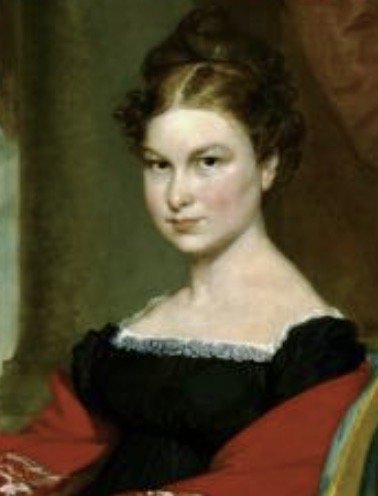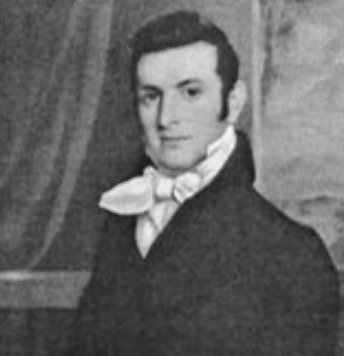Chance Discoveries in a Little Kennebunkport Park
On a late October afternoon, misty with rain incoming and fog casting early shadows over the coastal Maine town of Kennebunkport, my husband stopped at a vacant parking lot to video the nearby Kennebunk River and boats docked at the Arundel Yacht Club.
That looked uninteresting to me so I crossed Ocean Avenue and gravitated to various clumps of late-blooming flowers and bushes amidst showers of fall leaves from trees hovering overhead. Soon I stumbled upon a plaque that explained the peaceful, lovely vista.
I later learned that the Kennebunkport Conservation Trust had purchased, through donations, the River Green in 1976 and, in 2011, the townspeople surprised former First Lady Barbara Bush—who with her family summered on nearby Walker’s Point—with a public garden dedicated to her and all she had done for her family and country. The surprised even included the Barbara Bush rose. The charming small lot was named Ganny’s Garden, after what Barbara’s grandchildren called her.
Barbara had dedicated her life to the nurturing of her six children—one of whom later became president and one a governor—and her grandchildren. She had created a needlepoint carpet with the initials of all 17 grandkids hidden amongst flowers.
This was the theme of Ganny’s Garden, and the grandkids’ initials can be seen carved into the stone wall. Around the three traditional flower plots are three bronze pieces depicting what Barbara was known for around town: her mismatched sneakers, her sunhat, and her favorite book, Pride and Prejudice.
Further into the garden stands a statue honoring the hardy and determined men and women who had settled this coastal town: a fisherman and his wife with her work basket, with two large fish under their feet. The statue, I later discovered, was designed by Frank Handlen, a painter, sculpture, and shipwright, in 1994.
I would have stayed in the park until my husband was bored with his river endeavors, but I knew my time there was short. Something a bit mysterious and interesting was peeking through the greenery, luring me to walk up the green to Pleasant Street.
A sign on the perpendicular Greene Street read:
Lark Hotels had purchased several former sea captain homes, within a two block radius, that had been used in the past as bed and breakfast establishments. Lark recently transformed them into modern inns, and one of the homes was the former residence of Captain Nathaniel Lord, his wife, Phebe, and their 10 children (with another supposedly born to a servant girl).
I knew vaguely about the Lords of Kennebunkport, but had no idea where their grand house was situated. One of the inns was straight ahead, a commanding yellow mansion with a widow’s walk on top. In earlier years, anyone looking out its windows would have had a clear view of the river below and of sailing boats coming and going. This was the house that I saw vaguely through the garden arbor below.
I took photos of the house, having no idea if this was indeed the Lords’ place or one of the others listed which all stemmed from Phebe Lord’s father, Captain Daniel Walker, bequeathing land lots to his daughters and their families in the very early 1800s.
I took photos at various angles, and several photos of a few other interesting but slightly less commanding structures nearby, intending to find out later who had originally owned them.
It seemed, after doing some research, that my initial response to the yellow mansion was intuitive. This indeed was the Captain Lord mansion, designed by architect Thomas Eaton. Other inns in the Lark collection include the homes of William and Sally Jefferds, James and Lois Fairfield, and Acton Patterson. Sally and Lois were Phebe Lord’s sisters.
According to records online, Captain Nathaniel Lord, a very successful shipbuilder, never occupied his fine mansion. Construction began around 1812 during the war between the US and England when Nathaniel’s workers were hindered from building more boats. So he employed them as house carpenters. While he and his growing family lived next door, Nathaniel became ill and died in early 1815, just prior to the completion of the mansion. But the structure still goes by his name today and remained in the Lord family until the 1970s.
The real backbone of the Lord family, who kept all those underage children in one place, nurturing them and making sure they had the best education, was Phebe.
In the federal census records for 1820, Phebe, 39, was the head of the household, and many of her children were still living under her roof. By 1830, she was still there with several members of her family.
Oddly enough, years ago I had stumbled upon two of Phebe’s adult children and their accomplishments.
In Brunswick, Maine, one rainy day my daughter and I obtained the key to the First Parish Church and took a private tour of the interior of where Joshua Chamberlain, a Civil War hero, once worshipped, as well as the famed Victorian author Harriet Beecher Stowe.
While wandering through the Gothic sanctuary, I picked up a pamphlet for later reading. It was a reprint of a biography first published in 1850 regarding a former parish attender.
The author was Phebe Upham, the wife of a Bowdoin College professor at the time. The biography was about a freed slave woman she had known in Brunswick. Phebe Ann Jacobs, freed by her mistress, had lived in her own house and washed and ironed college student shirts for an income. She was a pious woman who attended the First Parish Church and led the other ladies, including Mrs. Upham, in cooperate prayers. Her funeral was well attended and her casket carried by local dignitaries.
Phebe Upham shared her biography with Harriet Beecher Stowe, who had moved to Brunswick with her professor husband sometime after Jacobs’ death. Phebe also shared with Harriet the temporary care of a runaway African American man heading to Canada. And Harriet was sitting with Phebe in the Upham church pew when she saw her famous vision of a black man being whipped to death.
If not for Phebe Upham’s feeding of Harriet’s imagination, would Uncle Tom’s Cabin ever have been written? Thus, President Lincoln would never have said to Harriet, after the book’s success, that she was “the little woman who wrote the book that started this great war.”
After living in Brunswick, I moved to Bangor and began hearing about the famed Veazie and Lord families who had dominated this lumber capital during its peak days in the mid-1800s. A large portrait is displayed in Bangor’s Thomas A. Hill house museum of a Nathaniel Lord, who I had heard grew up in Kennebunkport but later moved to Bangor.
During this time, I took a trip back to Brunswick and toured the Bowdoin College Museum of Art. I couldn’t help but admire a portrait by Gilbert Stuart of a spunky-looking young lady from the 1820s.
I was shocked, initially, to read her full name under the portrait: Phebe Lord Upham. The same Phebe who befriended Harriet in Brunswick was also the daughter of Nathaniel and Phebe Lord of Kennebunkport. Her brother was Nathaniel Lord of Bangor.
Nathaniel had attended the same Norwich Academy in Vermont as his father. After completing his education, he began a ship and lumber-related business in the booming city of Bangor in the 1830s with his Veazie cousin, one of the sons of General Samuel Veazie. The general was possibly the richest man in Maine at the time and had his hands in a variety of ventures: railroads, lumber operations, banks, and the founding of the town of Veazie.
One thing led to another and Nathaniel married the general’s only daughter, the impressive Frances. They settled down in Bangor, built the most modern mansion of its day which included indoor plumbing, and were raising six children at the time.
Then in 1849, Nathaniel and his father-in-law shipped a new steamboat, built in Bangor, to the coast of California on board a heavy cargo vessel that sailed around Cape Horn.
The steamboat made its maiden California voyage—as the fastest boat at that time—up the Sacramento River in the spring of 1850, during the height of the famed California Gold Rush when fast travel was worth a more expensive fare—up to $30 for an overnight ride. Nathaniel continued to travel via steamships back and forth to California from Bangor, managing the business prior to his untimely death in 1852 as the result of a stray bullet accidentally being discharged on his beloved Governor Dana. The bullet went into his chest, and he died on board. He left Frances with their six children in Bangor, with a seventh on the way.
Nathaniel’s mother experienced the death of several of her children through the years. But despite those losses and the loss of her husband, she did not remarry and maintained ownership of the Kennebunkport mansion. In the 1860 census, she was living there at the age of 79 with several other adults, although the census taker distinguished each person as having his or her own residency under the same roof. It’s not known if they were staying there as guests or as tenants.
Phebe’s real estate value that year was listed in the census as $800, and her personal estate was valued at $2,000.
Mary Lord, 74, most likely a relative, was also living in the same house. Her personal estate was valued at $400. A seamstress, Hannah Towne, 58, also occupied the mansion with a personal estate worth $300, along with Ruth Ward, 70, originally from Massachusetts, who was listed by the census taker as “insane.” Betsey Chatman, 64, was another occupant, and Henry Bradley, 28, who worked as a laborer, lived there with $100 worth of possessions.
The following year, Daniel Lord, another son of Phebe’s, was traveling through Philadelphia during the beginning of the Civil War. He wrote in a letter to his wife, Lydia, back in Kennebunkport, to “remember me to my dear mother.”
Phebe died in 1864. But her descendants lived on and many of them contributed in positive ways to this world. Perhaps her son Daniel’s request to his wife is an indication of the respect and affection Phebe’s children held towards her til the end of her life.
Phebe was strong for others, as Barbara Bush was strong. Both were affluent, both bore children to men who weren’t around that much, both continued to contribute to family and the societies they lived in long after their child-bearing years were over.
And both can be remembered, if only through chance meetings, through the little green park and yellow mansion in Kennebunkport.


















